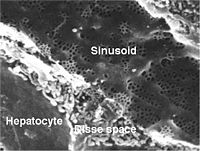
Photo from wikipedia
Owing to significant differences across species in liver functions, in vitro human liver models are used for screening the metabolism and toxicity of compounds, modeling diseases, and cell-based therapies. However,… Click to show full abstract
Owing to significant differences across species in liver functions, in vitro human liver models are used for screening the metabolism and toxicity of compounds, modeling diseases, and cell-based therapies. However, the extracellular matrix (ECM) scaffold used for such models often does not mimic either the complex composition or the nanofibrous topography of native liver ECM. Thus, here we develop novel methods to electrospin decellularized porcine liver ECM (PLECM) and collagen I into nano- and microfibers (∼200-1000 nm) without synthetic polymer blends. Primary human hepatocytes (PHHs) on nanofibers in monoculture or in co-culture with non-parenchymal cells (3T3-J2 embryonic fibroblasts or primary human liver endothelial cells) display higher albumin secretion, urea synthesis, and cytochrome-P450 1A2, 2A6, 2C9, and 3A4 enzyme activities than on conventionally adsorbed ECM controls. PHH functions are highest on the collagen/PLECM blended nanofibers (up to 34-fold higher CYP3A4 activity relative to adsorbed ECM) for nearly 7 weeks in the presence of the fibroblasts. In conclusion, we show for the first time that ECM composition and topography synergize to enhance and stabilize PHH functions for several weeks in vitro. Our nanofiber platform could prove useful for the above applications and to elucidate cell-ECM interactions in the human liver. This article is protected by copyright. All rights reserved.
Journal Title: Advanced healthcare materials
Year Published: 2023
Link to full text (if available)
Share on Social Media: Sign Up to like & get
recommendations!